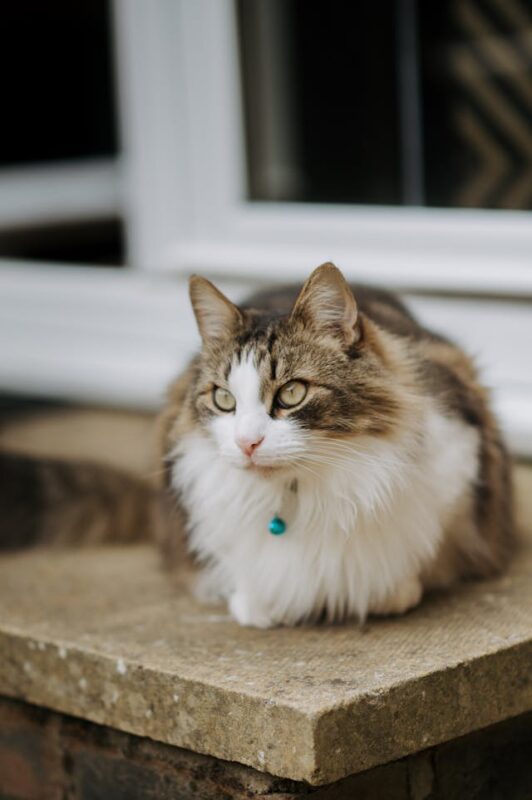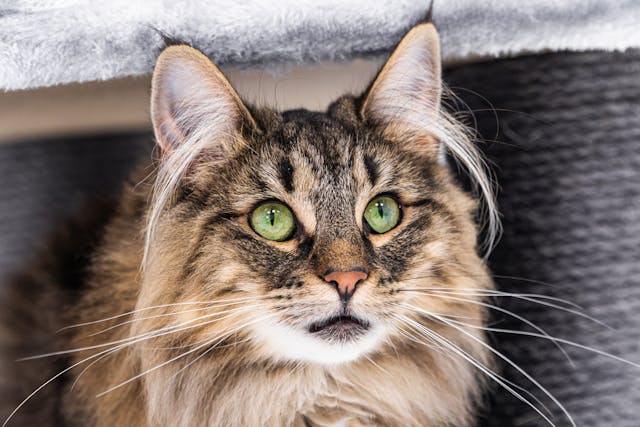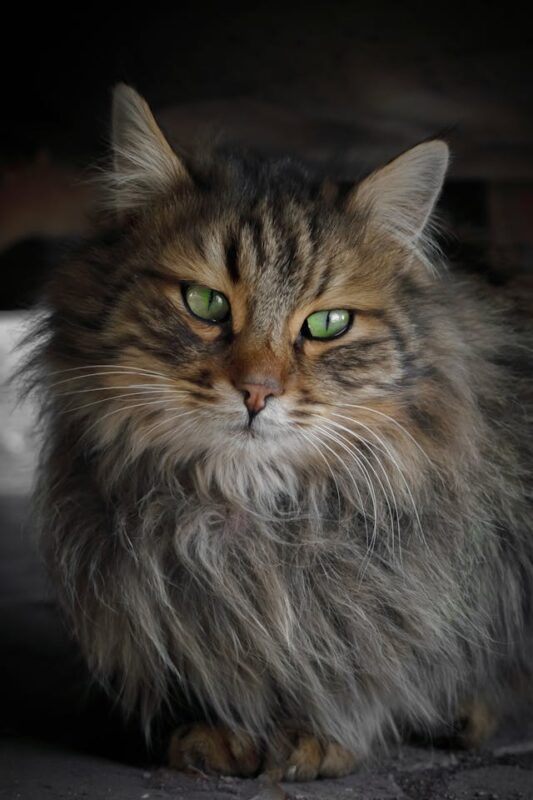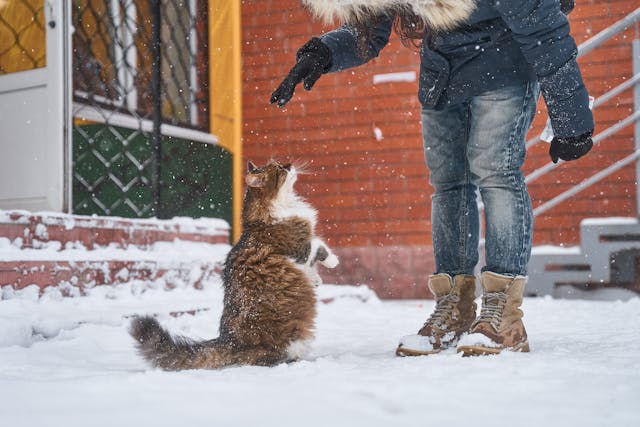Common Norwegian Forest Cat Health Issues
Posted: 09/10/2024 | BY: Jenna Bruce | Categories: Cat , Health problems , Pet care
The Norwegian Forest Cat, also known as “Wegie,” is a majestic and robust breed with a history that stretches back to the Vikings. Known for their powerful build and thick, water-repellent coat, These fur babies do very well in colder climates. But, as with any cat breed, the Wedgie is susceptible to certain health conditions. Keep reading to discover the most common Norwegian Forest cat health issues.

Top Health Problems of the Wedgie
The more a cat parent knows about their fur baby, the better able they’ll be to watch for health issues and have them treated as soon as possible. This knowledge and diligence will help ensure your Wedgie lives a long and healthy life.
With that in mind, the following are the most common Norwegian Forest cat health issues:
1. Hypertrophic Cardiomyopathy (HCM)
Hypertrophic Cardiomyopathy is a common heart condition in many cat breeds, including Norwegian Forest Cats. HCM is characterized by the thickening of the heart’s walls, which can make it difficult for the heart to pump blood effectively. This condition can lead to heart failure if not managed properly.
Symptoms to Watch For:
- Difficulty breathing
- Lethargy
- Fainting or collapsing
- Sudden paralysis in the hind legs
If you notice any of these symptoms, it’s important to seek veterinary care immediately. While HCM cannot be cured, it can be managed with medications and regular monitoring.
2. Glycogen Storage Disease Type IV
Wedgie’s are particularly susceptible to a rare genetic disorder known as Glycogen Storage Disease Type IV (GSD IV). GSD IV is an inherited condition that affects the metabolism of glycogen, a form of stored glucose. Cats with GSD IV are unable to properly process glycogen, leading to a buildup in the liver and muscles, which can cause severe health problems.
Signs of GSD IV:
- Muscle weakness and atrophy
- Difficulty walking or standing
- Growth retardation in kittens
- Sudden death in severe cases
Sadly, there is currently no cure for this disease and affected cats typically do not survive beyond a few months. Responsible breeders use genetic testing to screen for GSD IV.

3. Polycystic Kidney Disease (PKD)
Another genetic condition common to Wedgies is polycystic kidney disease. PKD leads to the formation of fluid-filled cysts in the kidneys. Over time they can increase in size, leading to kidney failure.
Symptoms of PKD:
- Increased thirst and urination
- Weight loss
- Vomiting
- Loss of appetite
There is no cure for PKD, but early diagnosis can be key to manage the disease and improve the quality of life.
4. Hip Dysplasia
When we hear the term “hip dysplasia” we typically think of an orthopedic condition affecting dogs. But hip dysplasia can also affect larger breeds of cat like the Wedgie.
This condition occurs when the hip joint does not develop properly, leading to arthritis and pain over time. Hip dysplasia can be hereditary, so it’s important to choose breeders who screen for this condition.
Symptoms to Look Out For:
- Difficulty jumping or climbing
- Limping or lameness in the hind legs
- Decreased activity level
- Pain when the hips are touched
Treatment options include weight management, physical therapy, pain medications, and in severe cases, surgery. Early intervention can help manage the condition and prevent further joint damage.

5. Feline Lower Urinary Tract Disease (FLUTD)
Feline Lower Urinary Tract Disease is a common condition in cats that affects the bladder and urethra. While not specific to Norwegian Forest Cats, their size and weight can make them more prone to developing urinary issues, especially if they are overweight.
Symptoms of FLUTD:
- Straining to urinate
- Blood in the urine
- Frequent trips to the litter box with little output
- Crying or showing signs of pain when urinating
FLUTD can be managed with dietary changes, increased water intake, and, in some cases, medication. Regular veterinary check-ups are important to monitor and manage this condition.
Final Thoughts on Norwegian Forest Cat Health Issues
The Wedgie is a hardy and resilient breed, but like all cats, they are prone to certain health issues. Being aware of the most common Norwegian Forest cat health issues will help you ensure your fur baby leads a long, healthy, and happy life.

Protect Your Feline Friend: The Lifesaving Benefits of Pet Insurance
Investing in your Norwegian Forest cat’s health is one of the best ways to ensure they live a long and happy life. While these majestic felines are known for their resilience, they can still face health challenges. From common issues like dental problems and obesity to genetic conditions like hypertrophic cardiomyopathy, veterinary care can quickly become costly. Pet insurance offers a safety net, giving you peace of mind knowing you can provide the best possible care without worrying about unexpected bills. Don’t wait until it’s too late—consider signing your cat up for pet insurance today and protect their well-being for years to come.
Thinking of insuring your pet?
Get Quotes & CompareReferences:
- https://www.petmd.com/cat/breeds/norwegian-forest-cat
- https://www.embracepetinsurance.com/cat-breeds/norwegian-forest-cat
- https://www.thesprucepets.com/norwegian-forest-cat-4170085
Disclaimer
The information contained on this blog is intended for informational and educational purposes only and should not be construed as medical advice. It is not a substitute for professional veterinary care. Always consult with your veterinarian before making any changes to your pet's health care or treatment plan.
The authors of this blog are not veterinarians and do not claim to be experts in pet health. The information provided here is based on our own experiences and research, as well as information from reputable sources. However, we cannot guarantee the accuracy or completeness of this information.
We encourage you to do your own research and consult with your veterinarian before making any decisions about your pet's health.
Previous post
Let's Celebrate Responsible Dog Ownership MonthCompare top pet insurance providers & plans.
Enter your dog’s age in years and months to calculate their age equivalent to human years.
Calculate your dog’s ageEnter your cat’s age in years and months to calculate their age equivalent to human years.
Calculate your cat’s age